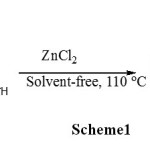A Novel Synthesis of Biscoumarin derivatives Catalyzed by Zncl2 Under Solvent-Free Conditions
Vahid Vahabi*, Farhad Hatamjafari,
Department of Chemistry, Faculty of Science, Islamic Azad University-Tonekabon Branch, Tonekabon, Iran
DOI : http://dx.doi.org/10.13005/ojc/300263
Article Received on :
Article Accepted on :
Article Published : 12 Apr 2014
Zinc chloride (ZnCl2) is used as an efficient catalyst condensation of 4-hydroxycoumarin and with various aromatic aldehydes leading to the formation of biscoumarin derivatives. Easy isolation of the products, short reaction times, excellent yields and reusability of catalyst was theadvantage of thismethod.
KEYWORDS:Bis-coumarins; ZnCl2; Aromatic Aldehydes; Solvent-free Conditions
Download this article as:| Copy the following to cite this article: Vahabi V, Hatamjafari F. A Novel Synthesis of Biscoumarin derivatives Catalyzed by Zncl2 Under Solvent-Free Conditions. Orient J Chem 2014;30(2). |
| Copy the following to cite this URL: Hatamjafari F, Vahabi V. A Novel Synthesis of Biscoumarin derivatives Catalyzed by Zncl2 Under Solvent-Free Conditions. Orient J Chem 2014;30(2). Available from: http://www.orientjchem.org/?p=2928 |
Introduction
Biscoumarin and its derivatives are of considerable interest due to their biological activities such as urease inhibitors1, HIV inhibitory activity 2, anticoagulant activity 3, treatment of thrombosis 4. From among various catalyst for synthesis of Biscoumarins, the following catalysts can be referred such as sulfuric acid, phosphorus pentoxide, aluminumchloride, iodine, and trifluoroacetic acid are employed 5-6, molecular iodine 7, [bmim][BF4] 8, tetrabutylammonium bromide (TBAB) 9, Zn(Proline)210, sodium dodecyl sulfate (SDS) 11.Previously, we have synthesized a number of heterocyclic compounds12-22. Herein, we report an efficient method for the synthesis of somebiscoumarin derivatives from aromatic aldehydes and 4-hydroxycoumarin catalyzed by Zinc chloride under solvent-free conditions (Scheme 1).
 |
Scheme 1 |
EXPERIMENTAL
All chemicals were obtained from Merck or Flukawithout further purification. Silica gel SILG/UV 254 plates were used for TLC. IR spectra were measured on a Shimadzu IR-470 Spectrophotometer. 1H NMR spectra were determined on Bruker400 DRX AVANCE instrument at 400 MHz, respectively.
General procedure for preparation of H1-H4
A mixture of aldehyde (1 mmol), 4-hydroxycoumarin (1 mmol), ammonium acetate (3 mmol) and ZnCl2(15mol %) as a catalyst was stirred at 110 oC for 35 min. The progress of reaction was monitored by TLC. After finishing, recrystallized from ethanol 95% to give pure products (H1-H4)
spectral data
3,3′-[(3-Nitrophenyl)methylene]bis(4-hydroxy-2H-chromen-2-one) (H1)
White crystals, Yield: (89%), mp 233-235oC. IR (νmax/cm-1) (VBr): 3120(arom. CH Str.); 1680,1630 (C=O Str.); 1540 , 1340 (NO2 Str.) ; 1490(C=C Str.).1H-NMR (400.13 MHz CDCl3): δ=6.15(H, s, CH); 7.40-7.61(6H, m, 6CH); 7.69(2H, t,3J=7.6 Hz, 2CH); 8.03(H, d, 3J=7.6 Hz, CH); 8.09(H, s, CH); 8.12( H, t, 3J=7.6 Hz, CH); 8.17(H, d, 3J=8.0 Hz, CH); 11.40(H, s, OH); 11.60(H, s, OH).
3,3′-[(4-Nitrophenyl)methylene]bis(4-hydroxy-2H-chromen-2-one) (H2)
White crystals, Yield: (87%), mp230-232oC.IR (νmax/cm-1) (VBr): 3140(arom. CH Str.); 1670,1610 (C=O Str.); 1580 , 1370 (NO2 Str.) ; 1480(C=C Str.). 1H-NMR (400.13 MHz CDCl3): δ=6.13(H, s, CH); 7.41-7.47(6H, m, 6CH); 7.69(2H, t,3J=8.0 Hz, 2CH); 8.02(H, d, 3J=7.6 Hz, CH); 8.10(H, d, 3J=7.8 Hz CH); 8.20( 2H, d, 3J=8.8 Hz, 2CH); 11.39(H, s, OH); 11.59(H, s, OH).
3,3′-[(2-Chlorophenyl)methylene]bis(4-hydroxy-2H-chromen-2-one) (H3)
White crystals, Yield: (90%), mp225-223 oC.IR (νmax/cm-1) (VBr): 3120(arom. CH Str.); 1660, 1620 (C=O Str.); 1490(C=CStr.). 1H-NMR (400.13 MHz CDCl3): δ=6.16(H, s, CH); 7.24-7.39(5H, m, 5CH); 7.41(2H, d,3J=8.0 Hz, 2CH); 7.49(1H, d,3J=8.0 Hz, CH); 7.64(2H, t, 3J=7.6 Hz, 2CH); 8.04(2H, m,2CH); 10.95(H, s, OH); 11.67(H, s, OH).
3,3′-[(2-Fluorophenyl)methylene]bis(4-hydroxy-2H-chromen-2-one) (H4)
White crystals, Yield: (85%), mp 215-217oC. IR (νmax/cm-1) (VBr): 3130(arom. CH Str.); 1675, 1605 (C=O Str.); 1510(C=C Str.). 1H-NMR (400.13 MHz CDCl3): δ=6.13(H, s, CH); 7.18-7.37(8H, m, 8CH); 7.43(1H, d,3J=8.2 Hz, CH); 7.65(2H, d,3J=8.2 Hz, 2CH); 8.03(2H, dd, 3J=28.0 Hz, 3J=8.0 Hz, 2CH); 11.33(H, s, OH); 11.56(H, s, OH).
RESULTS AND DISCUSSION
We have been able to introduce an efficient method for the synthesis of biscoumarin derivatives via condensation of 4-hydroxycoumarin with various aromatic aldehydes. Therefore, reported ZnCl2as catalyst which could provide an efficient, cheap, easy separationunder solvent-free condition for the synthesis of biscoumarins with high yield.
ACKNOWLEDGEMENTS
We gratefully acknowledge the financial support from the Research Council of Tonekabon Branch Islamic Azad University.
REFERENCES
- Khan K.M., Iqbal S., Lodhi M.A. and et al., Bioorg. Med. Chem.,12: 1963 (2004).
- Manian R.D.R.S., JayashankaranJ.andRaghunathan R., Tetrahedron Lett.,48: 1385 (2007).
- Manolov I., Moessmer C.M., Nicolova I. and Danchev N., Arch. Pharm. Chem. Life Sci., 339: 319 (2006).
- Lehmann J., Lancet, 241: 611 (1943).
- Yadav J.S., Reddy B.V.S., Basak A.K. and et al., Eur. J. Org. Chem., 546 (2004).
- Narsaiah A.V. andNagaiah K., Synth. Commun.,21:3825 (2003).
- Kidwai M., Bansal V., Mothsra P. and et al., J. Mol. Catal. A: Chem.,268:76 (2007).
- Khurana J.M. and Kumar S., Monatsh. Chem.,141:561 (2010).
- Khurana J.M. and Kumar S., Tetrahedron Lett.,50: 4125 (2009).
- Siddiqui Z. andFarooq F., Catal. Sci. Technol.,1:810 (2011).
- Mehrabi H. andAbusaidi H., J. Iran Chem. Soc.,7:890 (2010).
- Azizian J., Hatamjafari F., Karimi A. R. and Shaabanzadeh M., Synthesis. 5: 765 (2006).
- Azizian J., Shaabanzadeh M., Hatamjafari F. and Mohammadizadeh M.R., Arkivoc. (xi): 47 (2006).
- Hatamjafari F., Synthetic Communications. 36: 3563 (2006).
- Azizian J., Hatamjafari F. and Karimi A. R., Journal of Heterocyclic Chemistry. 43: 1349 (2006).
- Hatamjafari F and Montazeri N., Turkish Journal of Chemistry. 33: 797 (2009).
- Hatamjafari F., Orient. J. Chem., 28: 141(2012).
- Hatamjafari F., Orient. J. Chem., 29: 93(2013).
- Hatamjafari F and Alijanichakoli F., Orient. J.Chem.,29: 145(2013).
- Hatamjafari F and Hosseinian A., Orient. J.Chem.,29: 109(2013).
- Hatamjafari F and Khojastehkouhi H., Orient. J. Chem., 30: (2014 in press).
- Hatamjafari F and GermaniNezhad F., Orient. J. Chem., 30: (2014 in press).

This work is licensed under a Creative Commons Attribution 4.0 International License.









